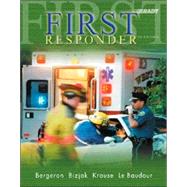
Note: Supplemental materials are not guaranteed with Rental or Used book purchases.
Purchase Benefits
What is included with this book?
| Preparatory | p. 1 |
| Introduction to EMS Systems | p. 1 |
| Legal and Ethical Issues | p. 17 |
| Well-Being of the First Responder | p. 33 |
| The Human Body | p. 53 |
| Lifting, Moving, and Positioning Patients | p. 67 |
| Airway | p. 93 |
| Airway Management | p. 93 |
| Patient Assessment | p. 135 |
| Assessment of the Patient | p. 135 |
| Circulation | p. 181 |
| CPR and Automated External Defibrillators (AEDs) | p. 181 |
| Illness and Injury | p. 227 |
| Medical Emergencies | p. 227 |
| Bleeding, Shock, and Soft-Tissue Injuries | p. 281 |
| Muscle and Bone Injuries | p. 351 |
| Childbirth and Children | p. 419 |
| Childbirth | p. 419 |
| Infants and Children | p. 454 |
| EMS Operations | p. 497 |
| Gaining Access and Hazards on the Scene | p. 497 |
| Multiple-Casualty Incidents, Triage, and the Incident Management System | p. 525 |
| Appendices | |
| Determining Blood Pressure | p. 541 |
| Breathing Aids and Oxygen Therapy | p. 547 |
| Pharmacology | p. 559 |
| Swimming and Diving Incidents | p. 569 |
| Response to Terrorism and Weapons of Mass Destruction | p. 577 |
| First Responder Roles and Responsibilities | p. 581 |
| Glossary | p. 583 |
| Index | p. 597 |
| Table of Contents provided by Rittenhouse. All Rights Reserved. |
The New copy of this book will include any supplemental materials advertised. Please check the title of the book to determine if it should include any access cards, study guides, lab manuals, CDs, etc.
The Used, Rental and eBook copies of this book are not guaranteed to include any supplemental materials. Typically, only the book itself is included. This is true even if the title states it includes any access cards, study guides, lab manuals, CDs, etc.